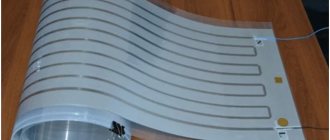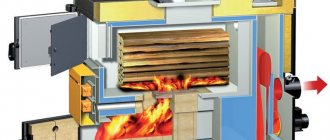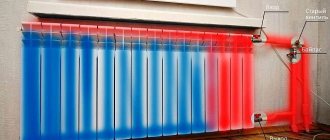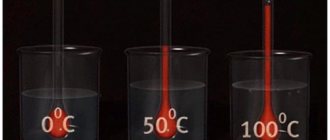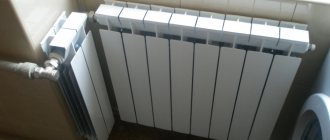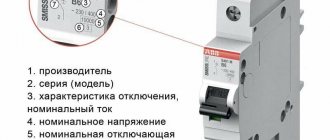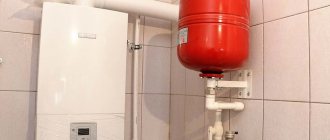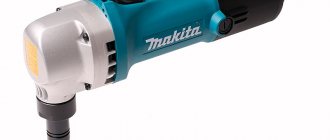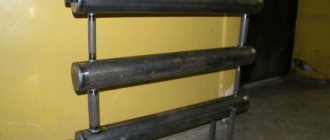One of the most common problems in functioning heating systems is airing, which leads to uneven heating of radiators or underfloor heating pipes. To combat this negative phenomenon, air vents for heating systems operating in different modes are widely used.
Using an air vent installed at the inlet of the heat exchange devices, air is released from the heating circuits. There are various types of air vents on the market, in order to understand the wide range of models and choose the right device for an individual heating system, you should know the operating principle, existing types and design features of manufactured air vents.
Rice. 1 Air vents
Design and operating principle of manual air valve
The needle manual air valve is also called a Mayevsky valve. His device:
- Brass body (plug) with external thread 1/2 // or 3/4 // for connection to the radiator. The case has two holes for air release Ø 2 mm - one at the end of the case, the second on the side wall;
- Brass locking screw. On one side of the screw there is a groove for a slotted screwdriver, on the other side the screw is machined into a cone that closes the air hole (the “closed” position);
- Plastic casing.
On sale you can find the so-called “faucet at hand”. To use it, you don’t need a key or a screwdriver—the plug can be easily unscrewed by hand.
To remove air from the housing, you need to unscrew the screw. To do this, you can, of course, use a screwdriver, but there are special keys that are most often included. After several revolutions, the screw cone comes out of the end hole and air enters the housing cavity, which is immediately released through the second side hole. The main thing is not to rush to turn off the tap. About 30 - 40% of the air should come out with water, so you need to stock up on time, a basin and rags. After the air has been released, the lost water must be added to the system.
Modern aluminum or bimetallic heating radiators already have a hole for installing a Mayevsky tap. It can be found on the side opposite the coolant supply, from above. Most likely, there is already a nut for installation there. There is a plastic plug screwed into it. After its removal, an air valve is installed in this place. Before this, the tap threads must be sealed with a rubber or silicone gasket.
Installing a Mayevsky crane on a cast iron battery is much more difficult. Let's start with the fact that these valves are much more powerful than those on aluminum radiators - they can withstand pressures of up to 16 atmospheres and temperatures of 150 C°. Sequencing:
- 1 Drain the water from the radiator;
- 2 Cut a hole in the top plug of the cast iron battery and cut a thread that matches the external thread of the air vent;
- 3 Screw in the Mayevsky tap;
- 4 Add water to the system.
Malfunctions and ways to eliminate them
If the faucet malfunctions, a leak appears. There may be several reasons for this:
- Manufacturing defects. One in fifty taps does not hold pressure at all. The only way out is replacement;
- The screw is too short. In this case, its conical part cannot completely block the hole, so you need to apply a certain force to screw the screw in until it stops;
- Solid particles of debris falling between the screw and the housing can damage the internal threads. Fum tape can help here once, but later you will still have to change the tap.
Mechanical
The body of a manual release is usually made of brass, has a simple design and small size. The main part of the entire Mayevsky faucet is a needle-type shut-off valve. To engage it and expel air, you need to turn the screw counterclockwise one turn with a special key, screwdriver or hand, depending on the model of the device. The needle opens a hole and gases escape through it. At this point, a faint hissing sound will be heard. As soon as all the air has escaped, coolant begins to flow out through the hole. After this, you need to tighten the screw all the way.
The only drawback of mechanical devices is that all operations with them have to be carried out manually.
What signs indicate the need to install an air valve?
In order to prevent air accumulation, heating engineers suggest using an air valve for heating from the very beginning of operation of the circuit, so heating specialists, in the drawn up heating diagram, give recommendations as to which air vent is suitable for a particular heating system.
However, in some cases, trying to save money on the purchase of this type of control valves, owners refuse to install the devices and thereby provoke a number of problems. To solve them, they have to install an air valve for the heating system after the circuit has been connected and connected to the boiler.
The following signs indicate the presence of air pockets and indicate the need to integrate an air vent into the heating circuit:
- uneven heating of batteries;
- the appearance of “cold spots” on the pipeline;
- poor circulation in the heating system;
- noise in heating devices;
- poor-quality heating of the house.
Finding a suitable installation location in the system
Taking into account the operating principle of an automatic heating air vent, it is usually used in the following areas:
- The highest point of the heating circuit (tops on vertical risers, etc.). This is where the internal air of the system usually accumulates.
- End areas of dead-end pipeline lines.
- Boiler piping safety group. Boilers using solid fuels especially need this. In this case, an automatic air bleeder is included in the set of instruments, which also contains a pressure gauge and an emergency valve. Thanks to the air vent, air is released as the coolant fills the water jacket of the boiler. In addition, the device increases the rate of water drainage when the heat generator is disconnected from the general system.
- Together with a circulation pump, which allows you to optimize its operation. This option is used only for those models of pumping equipment whose design provides for the possibility of installing an air vent. If the coolant is pumped with air, there will be a noticeable deterioration in the quality of the pump, even to the point of stopping it. All this leads to rapid wear of the impeller and bearings. Using a bleeder, you can also remove steam from the coolant if it overheats.
- Areas of the heating circuit where there is constant airing of the system. One of the reasons for such phenomena is an incorrectly calculated angle of inclination of the pipe.
- Heating appliances.
Incorrect security group setting
It is installed on the feed. Due to ignorance or illiteracy, many, when installing a safety group, place a shut-off valve between the boiler and the safety group (Fig. 1),
or directly to the security group (Fig. 2),
arguing that if the boiler fails, it will be possible to replace it or carry out repair work. In both cases, the installation was carried out incorrectly and, if the boiler fails, the service centers will refuse you warranty repairs, arguing that the boiler was installed incorrectly: this arrangement of the valve makes it possible for the system to overheat and the boiler to fail in case of shutdown shut-off valve by workers, third parties or children.
Types of automatic air vents
There are three types of these devices in total - despite this, the operation of the automatic air vent, or rather its principle, remains unchanged. In all cases, the same needle valve and the same float are used to open and close it - the only difference is in the position of the body relative to the connecting pipe, i.e. threaded connection.
- Direct automatic air valve for heating. The most common device for automatic air removal. It is intended only for vertical installation - in the sense that if you suddenly decide to use it for a battery, you will additionally need a 90-degree angle. The optimal area of their application is pipelines, or rather their upper points, where, according to all the laws of physics, the air generated in the heating rushes. If it were not for such devices, it would be very inconvenient to vent air at the highest points of heating systems. In addition, some heating system equipment is also equipped with automatic vents with direct connecting pipes. For example, an automatic air valve is an integral part of the boiler safety group, which also includes a pressure gauge and an explosion valve. Indirect heating boilers and other equipment are also equipped with air vents, at the top of which there is a possibility of air accumulations.
- Corner air vent. In short, corner air machines are used where it is not possible to install its direct counterpart - it may either not fit in the right place, or the equipment may have a side outlet with a thread. In general, there are many different situations, and it makes no sense to list them all, especially since the essence and principle of operation remain unchanged - only the location of the threaded outlet connection pipe and, as a result, the appearance of the Mayevsky automatic crane changes. A very important condition for the proper functioning of the corner air vent machine is the strictly vertical installation of its body. Horizontally and even at a slight angle, the machine will not be able to operate adequately - the float will get stuck and, as a result, air removal will be untimely or will not be removed at all.
- Automatic air vent for radiators. In essence, this is a type of angular machine for removing air, although you can’t tell from the outside - all these nuances are hidden inside the case. The outer part of the battery vent is created based on aesthetic considerations. In addition, these devices also differ in the diameter of the connecting pipe - on modern radiators they are installed directly into the battery, without the use of foot nuts. On old batteries they are mounted through a fitting with a threaded hole through it, and for steel convectors special machines with a half-inch pipe are used.
These are all the varieties that an automatic air valve for heating systems can boast of. In principle, you don’t need more, since regardless of the different installation conditions, one of them will still work.
Types of air vents in the heating system
Based on the principle of operation, they distinguish between ball and needle automatic devices, and according to design - straight, angular and radiator. Despite the different areas of use, the operating principle of all air vents is the same.
Special float devices are very popular. This is an automatic air vent that provides side air release. The device operates at an operating pressure of 10 bar, with a maximum permissible temperature of 110 degrees. The device can work not only with water, but also with various glycol solutions in concentrations up to 25%, and the connection thread is 1/2.
All modern automatic air vents are divided into several types, differing in general design. There are three main types of such devices:
- Angular;
- Straight;
- Radiator.
Direct air vent
The most common is the first type with a straight pipe. It is indispensable at the highest points of the system, where, according to all the laws of physics, the maximum amount of gases accumulates, and manual air release in such places is often difficult.
The closed system, which is constantly under pressure, is ensured by the boiler safety group. It is usually located on the supply pipe that exits the heat generator. In addition to the pressure gauge and safety valve, this kit also includes an automatic air vent for heating, which bleeds air when the tank is filled with liquid. If the unit is installed correctly, it can be separated from the system at any time and released for maintenance using a gas vent. For boilers operating on solid fuels, a safety group is required.
You can also find an air bleeder in circulator pumps. Its task is to create conditions for them to have an uninterrupted supply of water. The problem is that the pumping unit can only work with an incompressible medium. The penetration of air onto the pump impeller threatens to stop it completely. The active circulation of liquid is controlled by the gas vent.
Corner air vent
If the location is too inaccessible to install a simple valve (for example, the pipe is horizontal), use an angle version of the valve. Its pipe, rotated 90?, can be connected to the horizontal part. It is worth noting that the corner modification with external thread, except for the deployed pipe, is practically no different from its analogues, so these types are completely interchangeable.
Radiator automatic air vent
Sometimes, instead of the traditional Mayevsky tap, an automatic angle valve is installed on radiators. It is only slightly larger than its counterpart, a little more expensive (about $2), but does not require daily human intervention. This choice is justified if gases accumulate in the battery regularly due to the chemical reaction of the aluminum alloy from which the section is made and hot water.
Although for such cases they produce a special automatic device with a diameter like a radiator plug (see photo). The device is designed specifically for aluminum and partially bimetallic radiators and has a suitable connection type.
For cast iron batteries and old-type systems, the Mayevsky tap and drain pipe are more suitable.
Where can I buy
Among the domestic enterprises engaged in the production of ready-made hydroshooters is the Novosibirsk company TMK Gulfstream.
Hydraulic distributors are produced here from high-carbon steel with a thickness of 3 mm.
Simple devices with 4 pipes cost from 3.1 thousand rubles. (up to 50 kW). A similar device up to 100 kW will cost almost 4 thousand rubles.
There are models combined with a collector. Such a kit for three circuits will cost 6.8 thousand rubles. Five-circuit – 9.3 thousand rubles. Among the products there is also powerful boiler equipment. For example, a DN100 switch, designed to operate up to 500 kW, will cost 25 thousand rubles.
You can contact the organization by phone +7 913-953-16-80.
Many other manufacturers also produce hydraulic distribution equipment (only the prices are much higher):
- Italian company Immergas;
- Ariston;
- Meibes and others.
Reasons for appearance
Air can appear in the heating system for various reasons. If this is a one-time problem, you can simply delete it and not search for the source. If deflation is required several times during the season, you will have to look for the reason. Here are the most common:
- Repair and modernization of the heating system. During repair work, air almost always gets into the pipeline. It `s naturally.
- Filling the system with coolant. If you pour water into the system slowly, it carries little air with it, simultaneously displacing the air that is in the pipes and radiators. This is also an understandable process and does not require any special measures.
- Depressurization of joints and welds. This defect requires elimination, since airing will occur constantly. In individual heating systems, this phenomenon (leaky connections) is also accompanied by a drop in pressure. And this is another reason to look for faults. The most likely location is pipe and radiator connections. They may not be sealed. It is very difficult to look for them, since they do not always appear outwardly. If you notice that one of the compounds is leaking, everything is much easier - eliminate the drops. But if outwardly everything is normal, and air accumulates all the time, you have to coat the joints and seams with soap foam and observe whether new bubbles appear. After finding each “suspicious” connection, they are tightened, coated with sealant or repacked (the method depends on the type of connection).
Air can accumulate in pipe bends.
If the heating system already has air vents (valves for releasing air) and plugs begin to appear in it, you need to check the serviceability of the valves, as well as the tightness of the connections. The appearance of air in the heating system may be due to a rupture of the expansion tank membrane. In this case, you will have to change the membrane, and to do this you need to stop the entire system.
These are the most common places and ways in which air gets into radiators and batteries. It is necessary to kick him out of there from time to time, but when starting the heating in the fall, it is necessary.
Separators with magnetic traps
Pneumatex separators with magnetic traps (DN 20 – DN 400 mm) trap insoluble iron impurities in water much more effectively than conventional separators. The rod(s) with a powerful magnet are inserted from below from the outside into the separator sleeve and removed before the operation of washing out the sludge without violating the tightness of the system. The magnetic rod is separated from the water by the walls of the sleeve and does not require cleaning or protection from corrosion. The sleeve is made of non-magnetic material, so the magnetic particles quickly settle down and then the sludge is washed away through the valve. For effective flushing, the valve is offset from the center (creating a vortex effect). Separators with magnetic traps also contain conventional separating elements and have all the degassing and non-magnetic particle removal properties of conventional separator models.
Types of air vents
Automatic air vents differ in type of installation, size, and thread diameters. According to the location of the pipes they are:
- Vertical;
- Radiator;
- Corner.
The corner automatic air vent is convenient for installation on a radiator. In the place where the heating pipe enters it. With this installation, it will help to trap air and gases formed in the heating battery itself.
A vertical automatic air vent is best installed at the entrance to the heating system. With this arrangement, it will prevent air from entering the system.
The second option for installing a vertical model is at the top point of the heating system. This is where gases accumulate and prevent water or coolant from circulating effectively.
Radiator air vents are installed instead of a plug or Mayevsky valve in radiators. They are convenient, but it is advisable to install them on each radiator.
Why are there taps on radiators?
Each heating device is a separate element of the system that requires adjustment and periodic maintenance. If you control the coolant flow through the batteries depending on the heat demand, you can achieve good results in terms of energy savings. That is, radiator valves and heating taps are designed to solve the following problems:
- Complete isolation of the heating device from the system.
- Restriction of coolant flow through the battery.
- Change in coolant flow depending on external conditions.
- Bleeding air from the radiator and piping network.
There are many situations in which it is difficult to do without disconnecting the battery. For example, properly working central heating in the middle of spring, when it’s already warm outside, but it’s just hot in the apartment. Another case is the need to remove a heating device for the purpose of replacement, flushing or repair. In the absence of shut-off valves, carrying out any action with the radiator becomes problematic.
Valves are also installed on batteries in retro style
Restriction of the flowing coolant is carried out in order to balance individual heating in a private house or apartment
No matter what type of heating system you have, without balancing with valves, the first radiators will always receive more water than the last ones. Limiting the coolant flow at the beginning of the network and thereby balancing all devices with each other is the task of the control radiator fittings
Automatic control of the flow of incoming coolant is a way to save energy used to heat the house. If each tap on the heating radiator maintains the set air temperature in the room by controlling the flow of water through the radiator, then in general the system will consume only the required amount of heat, no more. And this is a considerable saving.
Well, the problem of air release when filling the system or during operation is also solved by special air valves installed on all modern radiators. Below is a list of types of shut-off and control valves, listed in the same order as the tasks they solve:
- Half-turn ball valves in straight and angle versions. Made from brass, bronze or polypropylene with a metal insert.
- Balancing valves for radiators – straight and angular.
- Regulating valves with thermal heads (thermostatic valves).
- Air drain valves – automatic and manual.
For reference. Some home craftsmen use three-way mixing valves to connect heating appliances. But such a solution is unreasonably expensive and is rarely used in practice.
Now we should consider in detail which taps are best installed on radiators in various conditions and circumstances. Some options are clearly shown in the video:
What are the dangers of air in the heating system?
Everyone has probably experienced more than once that the heating is turned on, but some radiator or a whole group does not heat up well or is completely cold. The reason for this is the air in the heating system. It usually accumulates at the highest point, displacing the coolant from this place. If a lot of it accumulates, the circulation of the coolant may stop altogether. Then they say that an air lock has formed in the heating system. In this case, professionals say that the system is airy.
To resume normal heating operation, the accumulated air must be removed. There are two options for this. The first is more often used in central heating systems. Taps are installed on the outer radiators in the branch. They are called descents. This is a regular valve. After filling the system with coolant, open it and keep it open until there is an even stream of water without air bubbles (then the water flows in jerks). If we talk about multi-storey buildings, then when the system is launched, the air vents on the risers must first be opened, and the remainder can already be discharged to the apartments.
The air in the heating radiator interferes with the normal circulation of the coolant. This causes the battery to heat up poorly
In private systems or after replacing radiators in apartments, special air valves, rather than ordinary taps, are installed to bleed air. They are manual and automatic. They are placed in the upper free manifold on each radiator (preferably) and/or at the highest point of the system.
What else threatens the air in the heating system? It promotes faster destruction of heating system components. Although polymers are used more and more today, there are still plenty of metal parts. The presence of oxygen promotes the activation of oxidation (ferrous metal rusts).
Balancing valve
The design of a valve for regulating heating differs from a conventional ball valve in that it can smoothly close the flow area in a few turns. Moreover, after balancing, the position of the valve can be fixed so that no one accidentally violates the settings. This type of control valves is installed at the outlet of the radiator, as shown in the diagram:
Shown here is the connection to a two-pipe horizontal system, most common in private houses and apartments with individual heating. By the way, the principle of installing fittings with a single-pipe scheme remains the same. A regular ball valve is installed on the supply line, and an adjustment valve is installed on the return line. In the case when a two-story house has a system with vertical risers, the installation diagram of the accompanying fittings looks like this:
The principle of product selection is the same as in the previous section
Straight or angular design is accepted depending on the layout of equipment and pipelines; it is also important to use American designs during assembly
Pay special attention to the quality of casting and the thickness of the brass walls of the fittings. If you have networks made of polypropylene pipes, do not rush to buy PPR taps; it is better to install adapters and reliable metal products
Advice. Balancing valves are installed on all radiators, except for the very last one, located at the dead end of the branch. It is enough to install simple ball valves on the connections to it.
Installation of an automatic air vent
Before installation, a comprehensive check of the device is performed. The housing must be free from dirt, rust and scale, if any. Next you need to do the following:
- The most convenient area for placing the air vent is calculated. It is advisable to think it over at the design stage of the heating system. The installation point must be as high as possible, must collect air and gases from all circuits and at the same time be accessible for maintenance.
- Using a shut-off channel or other connecting fittings (if necessary), tighten the automatic air vent valve so that the sealing material ensures a tight joint. If a corner or radiator device is used, then the working part of the housing with the chamber and float must be facing upward for unhindered air release.
- The air vent can only be tightened with an open-end wrench - it is not advisable to use lever wrenches.
- The tightness of the connection is checked, after which the cap at the top of the device body is unscrewed. Next, you can fill the branch with coolant.
What is an air valve
The air valve for heating is a sealed cone-shaped or cylindrical body made of brass. Inside it is a hollow float made of Teflon or polypropylene. This float is connected by a lever to the drain valve, which is equipped with a locking plug. This plug prevents coolant leakage if the device breaks down.
Air vents for heating systems come in three types:
- Direct devices of traditional type. They are mounted only vertically.
- Corner type devices that are installed at right angles. They are mounted on radiators instead of Mayevsky taps or in the event that a direct type of air vent cannot be installed.
- Special models for installation on radiators.
According to the principle of operation, the air vent can be manual (Maevsky tap) or automatic. The last variety is the float-type devices described above.
Operating principle of manual valve
Let's figure out how a manual air bleeder for a heating system works. To understand the structure of this type, you need to look at the drawing of the Mayevsky crane. At the end of the brass body with external thread there is a hole with a diameter of 2 mm. It is covered by a screw with a cone tip. On the side of the same body there is a hole of a smaller diameter, which is used to bleed air.
The operating principle of a manual air vent is as follows:
- In operating mode of the heating circuit, the shut-off screw is tightly tightened. The outlet is hermetically sealed with a cone.
- To release the air lock, the screw is unscrewed a couple of turns. As a result of coolant pressure, air begins to escape through a small hole, then enters the outlet channel and is discharged outside.
- Moreover, at first only air comes out of the hole, then an admixture of water appears. The tap must be closed when only a stream of water flows from the hole.
Because there are no moving parts to clog, rust, or wear out, a manual air vent is a reliable, trouble-free device. This valve is installed only on radiators.
Manual type valves are divided into the following types according to the method of unscrewing:
- a metal or plastic handle is used for opening;
- More often you can find a slot for a screwdriver with a flat working blade;
- To unscrew it with a special key, there is a screw with a tetrahedral tip.
Operating principle of automatic valve
The automatic air collector for the heating system works without human intervention. It is essentially a vertical brass cylinder with threads and a plastic float inside. The float is connected by means of a lever to the air release valve pressed by a spring. This valve is built into the lid.
The operating principle of an automatic air vent in a heating system is as follows:
- When the heating system is operating, the internal chamber of the device is filled with water, which presses the float up. As a result, the air valve is pressed by a spring and tightly closed.
- When air accumulates in the upper part of the chamber, the level of the coolant decreases, which causes the float to lower.
- When the liquid level drops to a critical value under the weight of the float, the spring compresses and opens the valve. As a result, the air begins to bleed out.
- Due to the increased coolant pressure in the system, all air is displaced from the chamber of the device. The liquid takes the place of the displaced air and causes the float to rise, which pushes the valve up and tightly closes the hole.
While the network is being filled with coolant, air pockets are constantly being bled off, since the float lies at the bottom of the container. When water fills the chamber, a spring mechanism raises the valve. As a result, the bleeding process stops. However, some oxygen remains in the housing under the cover, but this in no way affects the operation of the heating circuit.
Automatic devices come with angular and direct connection. The latter type discharges vertically, and the first - to the side. The corner version is valued for its reliability, but collects air bubbles worse.
How the device works
An air valve (or several) is installed in the heating system, in places where air bubbles are most likely to accumulate. This prevents the formation of a large traffic jam and the heating operates uninterruptedly.
Mayevsky crane
Such devices are named after the name of their developer. The Mayevsky tap has a thread and dimensions for a pipe with a diameter of 15 mm or 20 mm. It's structured simply:
- There are 2 through holes made in the body of the valve body, which in the open position of the Mayevsky tap communicate with the heating system.
- These holes are closed by a threaded screw with a conical tip.
- Air is released through a small (2 mm) hole directed upward.
In order to bleed air from the system, unscrew the screw 1.5-2 turns. The air escapes with a whistle as the communications are under pressure. The end of the air plug exit is characterized by a drop in pressure and the appearance of water.
On the market you can find several varieties of the Mayevsky tap, which are identical in design, but differ in the way they regulate the shut-off screw. There are:
- with a convenient handle for unscrewing by hand;
- with a regular head for a flat screwdriver;
- with a square head for a special key.
For an adult, the principle of unscrewing the locking screw does not matter. However, in a house where there are children, it is safer to use devices that should be unscrewed with a special tool. By unscrewing a regular tap with a comfortable handle, a child can be scalded by boiling water.
Automatic crane
The automatic air release valve is designed on the principle of a float chamber, the design includes:
- vertical housing with a diameter of 15 mm;
- float inside the housing;
- a spring valve with a cover, which is connected and adjusted by a float.
The automatic air valve for the heating system operates without human intervention. In normal condition, when there is no air in the system, the float is pressed by the pressure of the liquid filler to the valve cover. The lid is tightly closed.
As air accumulates in the valve body, the float moves down. As soon as it drops to a critical level, the spring valve opens and bleeds air out. Under the pressure of the carrier in the system, the space is again filled with liquid. The float rises, closing the spring valve cover.
When there is no coolant in the communications, the float lies at the bottom of the valve. As the system fills, air comes out of the tap in a continuous stream until the coolant reaches the float.
The following configurations of automatic air valves for heating are distinguished:
- with vertical air discharge;
- with side air discharge (through a special jet);
- with bottom connection;
- with corner connection.
For an amateur, the design features of an automatic crane do not matter. However, for a professional there is a difference in choosing between devices.
It is believed that:
- a device with a jet and a side hole is more reliable in operation than an automatic valve with vertical air discharge;
- a bottom-mounted valve traps air bubbles more effectively than a side-mounted valve.
If the design of the Mayevsky crane has not undergone changes for many years, the design of automatic valves is constantly being improved and supplemented.
Manufacturers offer automatic valves with additional devices:
- with a membrane to protect against water hammer;
- with a shut-off valve for easy dismantling of the device during the heating season;
- mini valves.
Automatic heating air valves require frequent inspection and cleaning. The undoubted advantages of these devices include the ability to install them in hard-to-reach places.
Ball
Sewage flooding is especially likely in high-rise buildings, where several apartments are located on one vertical pipe. Even one plastic bag may be enough to clog the riser, and then yes, not finding its way, will rush back, splashing out of all the drain holes. This situation is especially likely in old houses, where the pipes are covered on the inside with thick crusts of deposits.
The risk of backflow of waste water is especially high in apartments on the ground floor. Often at night in such apartments it is necessary to plug the drains with rags, plugs and other improvised plugs. But if valves are installed on the first floors, water can break through on the second floor. Up to the third floors, the pressure is usually not enough, and if it is strong enough, it will simply destroy the blockage and the water will go into the pipe.
So, it’s worth installing a check valve if:
- Your apartment is located on the first or second floor.
- You live in an individual home: a cottage, a dacha, a private house.
- The house was built a long time ago and there has been no major repair of the sewer system or replacement of risers.
- According to neighbors, there are frequent cases of sewer blockages in the house.
In this case, the small costs of purchasing and installing protective devices will pay off handsomely, allowing you not to worry about sudden costs and hassle.
If your home has a common riser valve installed, it can reduce the risk of flooding. But in problem apartments it is better to install separate valves on each drain to be completely sure.
Device
In 2022, there are many options for such a unit. They differ in materials, sizes and shapes, locking methods and many other parameters. But all types of valves have the same purpose - to cut off sewer water in the pipe that rushes sharply in the opposite direction.
Almost any design has the following elements:
- The pipes through which drained water enters and leaves the valve.
- A handle that closes the valve forcibly. It can be used when cutting off drains at night, or when trying to unclog a sewer system.
- A removable cover that allows you to inspect the condition of the valve and, if necessary, clean its parts from contamination.
- Locking mechanism. A ball valve is a rubber ball, but membranes, flaps and other devices can also be used.
The valve will not work if the “input” and “output” are reversed. Typically, the direction of movement of the drains in the valve is shown by an arrow marked on the body. Take this into account during installation!
Main types
First of all, valves vary in diameter. In the standards for sewer installation, left over from Soviet times, a diameter of 110 mm is established for risers, and all other pipes have a diameter of 50 mm. Today, non-standard options have appeared, for example, with a diameter of 75 mm, but they are significantly less widespread.
Various materials are used to make shut-off devices. They can be either metal (bronze, brass, stainless or carbon steel) or polymer (PVC, polyethylene). Each option has its own advantages and disadvantages:
- Metal products are significantly more expensive. They are durable, but require attention to their condition and periodic maintenance.
- Plastic valves are cheaper. They practically do not corrode. But the mechanical strength of such structures is less.
The design of check (or fan) valves also differs. Here are the most common options:
- The ball valve has a very simple design: a rubber ball is loosely located in the pipe, the diameter of which is slightly larger than the overall diameter of the pipe. When the liquid moves in the forward direction, the ball moves into a special chamber, and when it moves in the opposite direction, the ball, picked up by water, tightly plugs the neck of the pipe. Thanks to such a simple design, there is simply nothing to break in this device.
- Wafer device. The most compact option. This valve is convenient for installation in confined spaces. But if it fails, you will have to disassemble part of the system in order to repair or replace the faulty unit.
- Lift and rotary valves have spring-loaded flaps in their design. Such devices are relatively large, heavy and not cheap. The advantage is the ability to easily disassemble for cleaning, adjustment and minor repairs.
The choice of a specific type of device depends on the budget allocated for repairs, installation location, type of pipe and existing conditions.
How to properly install an air valve for sewerage, read the article: here
Design and operating principle
The automatic air valve for heating systems has a simple and reliable design. The hollow metal body is equipped with a connecting pipe, which is located at the bottom or side, depending on the version of the product. In the inner chamber of the device there is a float made of polymer resin. The float is connected by a lever rod to a needle valve that closes the hole in the upper part of the air vent cover.
When removing the plug using a manual valve, you need to control the process in order to shut off the device in time - the air will be completely released when a trickle of coolant flows through the vent. Installing an automatic air vent eliminates the hassle of servicing the heating system.
The operating principle of the device is based on the use of gravity - a hollow float is lighter than water, but heavier than air. In the normal state, the air extractor is filled with coolant, due to which the float is in the upper position, pressing the needle valve. Over time, the coolant is displaced from the internal chamber of the device by accumulating gas.
As a result, the float falls down under the influence of gravity, opening the valve slightly. The accumulated air under the pressure of the liquid in the heating system comes out through the hole in the drain body, and the chamber is again filled with coolant, which raises the float, automatically closing the valve.
Float ventilators serve to remove air pockets and also help speed up the draining of coolant from the system during maintenance or repair work. Due to a decrease in the coolant level in the circuit, the valves automatically open, and the air entering through them causes the liquid to drain faster.
Reasons for airing the system
Air in the heating circuit negatively affects the function and durability of the system. Oxygen reacts with steel and causes corrosion. Air locks interfere with the normal movement of the coolant, blocking the heating of the upper part of the radiators or entire heating devices. The presence of air bubbles in the coolant leads to premature wear of the moving parts of circulation pumps.
Air-filled heating system
There are several reasons for the formation of air jams
:
- Using water from a water supply system as a coolant that has not undergone special treatment to remove dissolved air. When heated, gases leave the liquid medium and accumulate at the upper points of the pipeline and batteries.
- Excessively fast filling of the system with coolant or its supply is not from the lowest point. In such a situation, the liquid does not have time to displace air from all corners of the installed system.
- Loss of system tightness due to installation errors or damage to elements.
- The use of polymer pipes that do not have a barrier coating, which prevents the penetration of oxygen molecules into the coolant.
- Errors when developing a project or arranging a system (incorrectly chosen angle of inclination of pipes, etc.).
- Air entering the system during repairs that require dismantling circuit elements.
Operating instructions
- Modern models of devices are equipped with elastic gaskets so that the connection to the radiator and pipeline is elastic and reliable.
- If the presence of a gasket is not enough, plumbing thread is wound at the joint or linen tow and putty are used.
- Installation is available without inviting a plumber. To connect to the system, just use an adjustable wrench.
- Experienced plumbers recommend installing an automatic air vent, the operating principle of which involves effective bleeding of air, not from the blind radiator plug, but on the inlet pipe - between the radiator and the tap.
Set it and forget it: is that true?
The Smart Home system implies the presence of various devices that create comfortable living in the house. The monitoring device periodically requires attention, despite its autonomous operation. Over time, the air vent begins to bleed not only air, but also water. The needle valve stops opening and closing independently due to the jamming of the polymer resin float. The light weight and soft texture of the core make it vulnerable to the slightest ingress of debris and hard abrasive particles.
